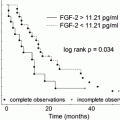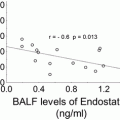Rapid progression (n = 54)
Slow progression (n = 55)
p
Age at examination (years)
14.6 ± 7.5
16.5 ± 5.1
NS
(0.7–24.0)
(7.3–25.0)
NS
Age at CKD diagnosis (years)
9.9 ± 6.8
5.6 ± 6.1
0.001
(0.01–22.0)
(0.1–20.0)
Etiology of CKD:
Chronic primary glomerulonephritis
24
6
Chronic interstitial nephritis
30
49
CKD duration (years)
2.6 ± 1.6
11.3 ± 4.8
0.0001
(0.01–6.0)
(3.0–22.5)
Proteinuria/CKD (g/24 h)
2.66 ± 4.32
0.59 ± 1.53
0.00001
(0–25)
(0–11)
Proteinuria/E (g/24 h)
1.23 ± 2.16
0.59 ± 0.99
NS
(0–10)
(0–6.2)
NS
Serum cholesterol/CKD (mmol/l)
5.55 ± 2.14
4.39 ± 0.95
0.0015
(2.1–12.0)
(3.0–8.5)
Serum cholesterol/E (mmol/l)
4.90 ± 1.80
4.90 ± 0.90
NS
(2.9–11.4)
(3.1–6.9)
NS
Presence of hypertension/CKD, n (%)
27 (50)
15 (27)
0.01
Presence of hypertension/E, n (%)
27 (50)
15 (27)
0.01
2.1.2 Parents of Patients Chronic Kidney Disease
The mean age of the mothers and fathers was 42.3 ± 7.7 and 45.2 ± 7.8 years, respectively. None of the parents presented a documented renal dysfunction, diabetes or impaired fasting glucose, while hypertension (defined as systolic blood pressure ≥140 mmHg and/or diastolic blood pressure ≥90 mmHg documented in the medical records on at least two separate occasions, or antihypertensive treatment) was present in 3.6 % (n = 4) and 9.8 % (n = 11) of the examined mothers and fathers, respectively.
2.1.3 Control Group
The control group served only for the comparison of the serum TGF-beta1 concentration with that in patients. The group consisted of children and young adults without clinical signs and family history of renal disease (n = 40; mean age 14.6 ± 4.8 years; gender: 50 % male, 50 % female).
2.2 Genotyping
2.2.1 The rs 1800471 Polymorphism
The rs1800471 polymorphism in TGFB1 gene was genotyped in the family trios: patients affected with chronic kidney disease and their both parents. Genomic DNA was extracted from frozen whole blood samples containing EDTA as an anticoagulant using the MasterPure TM DNA purification kit (Epicentre Technologies; Madison, USA) and resuspended in TE. Genotyping was performed by the method described previously by Wood et al. (2000). Primers (Tip MolBiol; Berlin, Germany) used for amplification were as follows: forward 5′ TTC CCT CGA GGC CCT CCT A 3′; and reverse: 5′ GCC GCA GCT TGG ACA GGA TC 3′. PCR amplification was performer in a total volume of 25 μl which contained 100 ng of genomic DNA. The reaction mixture contained: 10 mmol/l Tris HCl, pH 8.8, 50 mmol/l KCl, 1.5 mmol/l MgCl2, 0.1 % Triton X-100, 2.5 mmol/l of each deoxynucleotide triphosphate, 10 pmol of each primer, 1.5 mmol/l magnesium chloride and 0.6 U of thermostable Taq DNA polymerase (DyNAzyme TM II, Finnzymes; Vantaa, Finland). PCR amplification consisted of an initial denaturation at 94 °C for 5 min, followed by 35 cycles of denaturation at 94 °C for 1 min, annealing at 58 °C for 1 min, and extension at 72 °C for 1 min, and a final extension at 72 °C for 10 min. PCR products were digested with Bgl I enzyme (Fermentas; Ottawa, Canada) for the detection of polymorphism +915G/C of TGFB1 gene. All samples were analyzed on 4 % agarose gel electrophoresis and visualized by ethidium bromide staining in UV light (Vilber Loumat transilluminator UV; Marne-la-Vallée, France). Genotyping was performed in a blinded fashion.
2.2.2 Other Data Processing
We tested the transmission of alleles of rs1800471 polymorphism in TGFB1 gene from heterozygous parents to offspring affected with chronic kidney disease using TDT. We analyzed also whether rs1800471 polymorphism in TGFB1 gene had any impact on the loss of glomerular filtration rate (rapid vs. slow chronic kidney disease progression).
Serum TGF-beta 1 concentration was measured with an immunoenzymatic method using ELISA kits (R&D Systems; Minneapolis, USA). The results were expressed in ng/ml.
2.3 Statistical Analysis
Basic characteristics for qualitative parameters were shown as absolute numbers and percentages. Quantitative data was expressed as means ± SD. The normality of distribution of the continuous variables was checked with the Shapiro-Wilk test. In the statistical analysis, ANOVA Kruskal-Wallis test, Mann Whitney U test, and chi-squared test were used.
The TDT was used in the family-based study. The observed transmission was compared with the transmission expected for no association (i.e., random transmission, 50:50 %), using McNemar’s test (Ewens and Spielman 1995, 2005). Alleles transmitted significantly greater than 50 % of the time to an affected offspring provide evidence of disease association.
P < 0.05 was considered significant. All calculations were performed using Statistica 7.1.
3 Results
The characteristics of the two study groups according to progression of chronic kidney disease were shown in Table 1. The mean ages, 24-h proteinuria, and serum cholesterol of the patients at the time of the study were similar in both groups. However, patients with fast progression of the disease had higher 24-h proteinuria, serum cholesterol, and blood pressure at the time of diagnosis and higher blood pressure at the time of examination than the patients with slow progression of the kidney disease. Kidney disease caused by chronic glomerulonephritis was more frequently associated with fast progression, compared with that caused by chronic interstitial nephritis.
There were only GG and CG genotypes of rs1800471 polymorphism among patients with chronic kidney disease and their parents. The distributions of genotypes and alleles in the studied groups were shown in Table 2. The differences in genotypes and alleles frequencies between patients from CGN group and CIN group were insignificant (chi-square test; p = 0.35). Lack of association between the analyzed polymorphism and loss of glomerular filtration rate (fast vs. slow progression of disease) was found in the total group of patients and in the subgroups with different disease etiology (Table 2).
Table 2
Distribution of genotypes and alleles of rs 1800471 (+915G/C) polymorphism in TGFB1 gene in the groups of patients with chronic kidney disease (CKD) and their parents
All CKD patients (n = 109) | CGN (n = 30) | CIN (n = 79) | ||||
|---|---|---|---|---|---|---|
Genotype, n (%) | ||||||
GG | 96 (88.1) | 25 (83.3) | 71 (89.9) | |||
CG | 13 (11.9) | 5 (16.7) | 8 (10.1) | |||
Allele, n (%) | ||||||
G | 205 (94.0) | 55 (91.7) | 150 (94.9) | |||
C | 13 (6.0) | 5 (8.3) | 8 (5.1) | |||
Rapid progression (n = 54) | Slow progression (n = 55) | Rapid progression (n = 24) | Slow progression (n = 6) | Rapid progression (n = 30) | Slow progression (n = 49) | |
Genotype, n (%) | ||||||
GG | 46 (85.2) | 50 (90.9) | 20 (83.3) | 5 (83.3) | 26 (86.7) | 45 (91.8) |
CG | 8 (14.8) | 5 (9.1) | 4 (16.7) | 1 (16.7) | 4 (13.3) | 4 (8.2) |
Allele, n (%) | ||||||
G | 100 (92.6) | 105 (95.5) | 44 (91.7) | 11 (91.7) | 56 (93.3) | 94 (95.9) |
C | 8 (7.4) | 10 (4.6)
Stay updated, free articles. Join our Telegram channel
Full access? Get Clinical Tree
 Get Clinical Tree app for offline access
Get Clinical Tree app for offline access

| ||||


